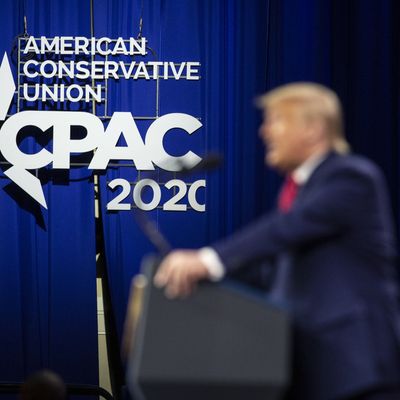
In 2014, a dissident group of conservatives held their own counter CPAC called the Uninvited. It featured speakers on the hard right such as Senator Ted Cruz and Representative Mo Brooks and featured a welcome address from Steve Bannon, whose then-website Breitbart sponsored the event. Inside CPAC that year were Carly Fiorina, Senator Pat Toomey, and foreign-policy veteran John Bolton.
Fast-forward to CPAC in 2021. Cruz and Brooks, who both vocally supported Donald Trump’s challenge to certifying Joe Biden’s win on January 6, are speaking at CPAC. Fiorina voted for Biden, Toomey voted to convict Trump in his second impeachment trial, and Bolton became a vocal Trump critic who was cited as a key witness in the first impeachment trial.
Matt Schlapp, the president of the American Conservative Union, the organization that puts on CPAC — short for the Conservative Political Action Conference — told Intelligencer that conservatives aren’t facing any underlying existential questions about what they believe after Trump’s loss in the 2020 election: “I don’t think there’s much controversy about that.” Instead, Schlapp thought that the debate now simply focused on “tactical questions” about the shape of the new conservative coalition.
Schlapp said that before Trump took over the party, CPAC explored “this whole question about whether we should kind of be courtly and mannerly with our disagreements or should we be more aggressive. And I think the decision of the movement is let’s be aggressive.”
Schlapp noted of the Trump skeptics who used to attend, “Some of these critics we’ve invited year after year and maybe they used to come and they don’t come any more.” He described it as a kind of natural selection.
“They don’t feel comfortable appealing before a raucous arena of conservatives and the conservatives probably don’t want to hear from them. I think it’s good for politicians to still come because if your message is contrary to where the conservative monument is, you have to ask yourself: Are you really a conservative?”
This year’s event will be held in Orlando, Florida, to evade the coronavirus restrictions in the Washington, D.C., area. The agenda focuses on Trump-era grievances, with seven different panels revisiting the 2020 election as well as the broad underlying theme of “cancel culture.” It will feature the first public appearance by Trump himself since leaving office as the capstone of the four-day conference.
The role of CPAC on the right has changed since it was founded in the early 1970s. Then, the Republican Party still featured genuine liberals like Nelson Rockefeller and Jacob Javits. Conservatives were just one faction of the party, not the party itself. Since then, it has evolved with the grassroots. In the Obama era, there was a strong presence of libertarians aligned with Ron and Rand Paul and, under Trump, red MAGA hats replaced yellow Gadsden flags as the accessory of choice.
“I think there was a period of time where people considered CPAC ‘this is the crazies, this is carnival, this is separate than real business of conservative politics.’ And that’s clearly not the case now,” said Tim Miller, a former Republican operative turned vocal Trump critic, “but I’m starting to question now whether it ever was.”
Miller worked for Jeb Bush’s presidential campaign when the former Florida governor attended, despite the fact that it was not his natural habitat. “This is where the crazy Republicans gather, not Jeb voters,” remembered Miller. “We’ll go there to demonstrate that Jeb can appeal to all sides of the party and maybe pick up a few strays.” As it turned out, “the CPAC audience was the primary electorate and [Bush] wasn’t welcome there because he wasn’t welcome among primary voters.”
For a large contingent of attendees who sit through every minute of the conference, CPAC is their vacation. For others, it’s a raucous party: Young conservatives show up to hear fiery speeches during the day and get absolutely lit at night. Then there are the professional operatives and D.C. journalists for whom this is a networking event, a chance to woo clients and cultivate sources. They’re there to swap some business cards and expense some drinks. Finally, there is just the fringe attracted by a big crowd and a large press pen. If you too want to turn yourself into an alt-right martyr or just shout at national reporters, CPAC is the place.
Terry Schilling, an ACU board member who met his wife at CPAC, which he first attended in 2006, described the event “as really a reflection of the conservative movement and where it is headed.” He noted when he first went to the event, attendees all seemed to wear “bow ties, sport coats, and boat shoes.” Schilling argued the crowd was now far more diverse: “There are truckers and people with tattoos and purple hair,” and it was an event that was no longer reliant on people who read National Review.
And, for Schlapp, the CPAC crowd was the perfect litmus test of conservative feeling in the country. “It’s a random association of people who buy their own tickets, come from all over the country, and it’s not a cheap thing to attend. If that’s not an example of where the conservative movement is, I don’t know what would be.”





























